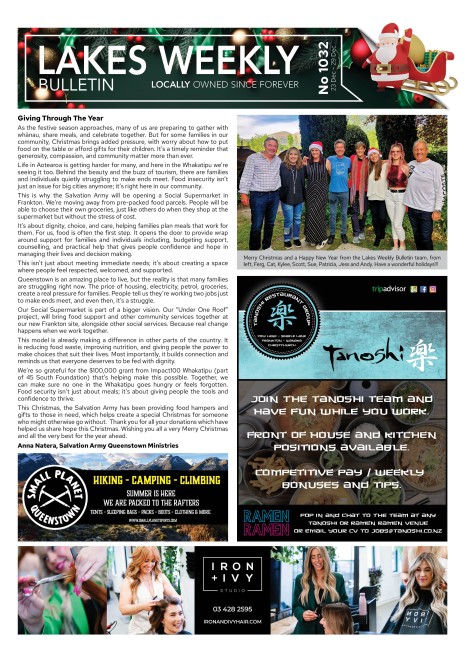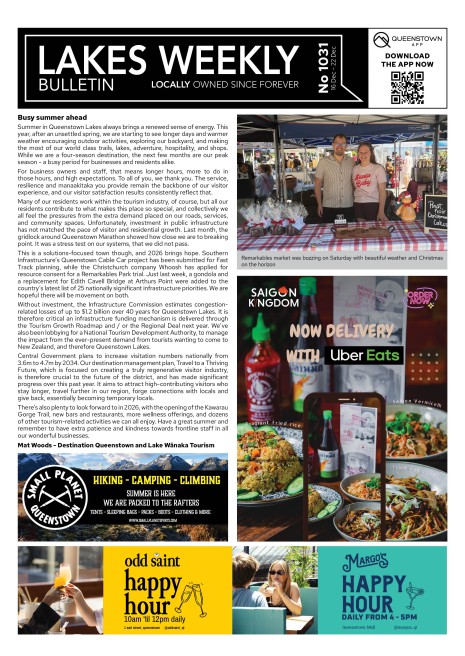Joseph Mooney - MP for Southland

Being part of positive change is one of the key drivers for me as your local MP and there have been some satisfying recent developments for the Queenstown Lakes.
The first might not sound exciting, but it is incredibly important. Health NZ has announced they’re commencing clinical services planning for Queenstown Lakes and Central Otago. This is significant because to green-light new health infrastructure, the first step is always a clinical services plan which provides the foundation for future decisions.
Since the last election I’ve been leading, alongside QLDC Mayor Glyn Lewers and CODC Mayor Tamah Alley and local health professionals plus fellow MPS Miles Anderson and Todd Stephenson, a locally-driven group called The Otago Central Lakes Health Services and Assets Project.
We have a goal of improving public health services in the combined Queenstown Lakes and Central Otago districts (Otago Central Lakes). Southern Lakes Health Trust clinical advisor Dr Jez Leftley and health infrastructure specialist Helen Foot have also been major drivers of our proposal, and their valuable input has been immense.
We’ve done a huge amount of work to surface the relevant data for our districts. A big win is that Health NZ will use our councils’ population projections - rather than the projections they had been using which significantly underestimated population growth at only 1.7% per annum.
Queenstown and Central Otago have been growing quickly whilst public health infrastructure hasn’t. The current Lakes District Hospital, in Queenstown, was built in 1988 when the Otago Central Lakes population was 30,000 people. It’s the only Emergency Department in the wider Central Lakes region, which now has a population of almost 80,000.
It is a fantastic outcome that Health NZ has acknowledged the data we have surfaced and is making this crucial step to decline a clinical services plan, with it expected to be completed by December. That is incredibly fast for a plan of this type.
There are great advocates and brilliant health professionals in Otago Central Lakes, and the work of folks in our region will help shape Health NZ’s clinical services plan to determine what services are needed, and how we can work with existing public and private providers to uplift health service delivery going forwards.
On a related note, we have also had the announcement of a Memorandum of Understanding between our councils and the Government to begin negotiations for a Regional Deal for Otago Central Lakes – the only region in the South Island to be selected. The Regional Deal proposal included health as a cornerstone.
This is a huge vote of confidence by the Government in Otago Central Lakes and something I have been working on with our mayors and councils, and have been strongly advocating for in Wellington.
Last week I also met with officials from NZTA to discuss the progress of work around the BP roundabout. I am aware a key concern from some has been the 4-year timeframe which was something I wanted to discuss. I am advised that work could go faster if the intersection could be closed for periods of time, but that isn't possible as it is one of the busiest intersections in the South Island.
Other recent highlights have been seeing the Government’s responsible fiscal management supporting the Reserve Bank to keep the Official Cash Rate low. There has been a 2.25 percentage point reduction in the OCR since August last year – easing the cost of borrowing and delivering much needed relief for many New Zealand households.
The Government has also significantly improved the FamilyBoost scheme to ease pressure and put more money back into parents’ pockets.
Families can now get back 40 per cent of their early childhood education (ECE) fees, up from the previous 25 per cent. We’ve also lifted the maximum weekly rebate from $75 to $120, meaning the most any family can get is now $1,560 per quarter.
We’ve also raised the income threshold, so households earning up to nearly $230,000 may now be eligible. Thousands more families - including many in our community - will now get some relief with their ECE costs.








